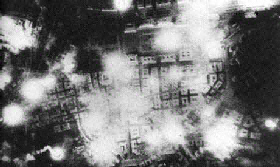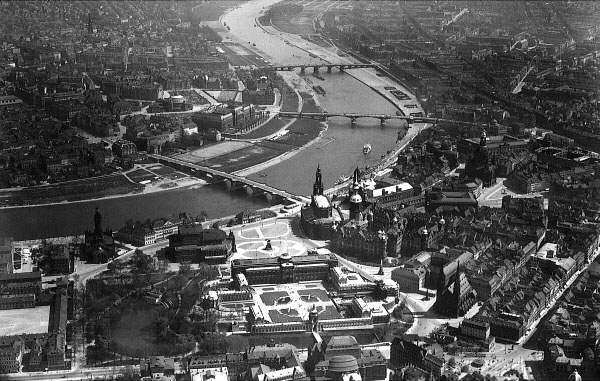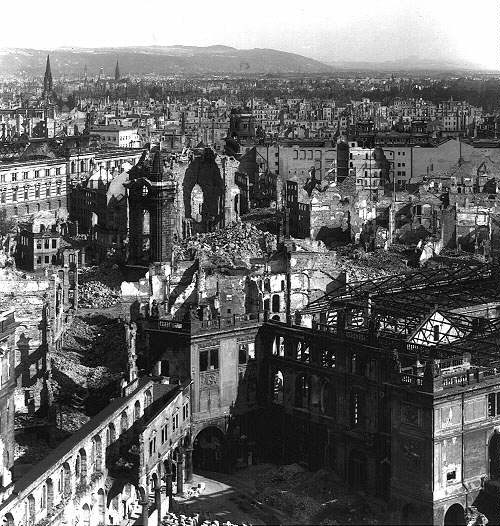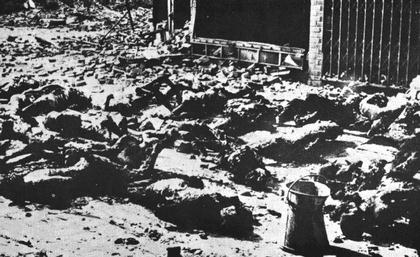|
THE RAID 
Somewhere between 35,000 and 135,000 civilians were killed in the Feb. 13-14, 1945 Attack.
The Bonn government is attempting to use the commemoration of the Dresden bombing to
expand German imperialism's diplomatic and military reach. Working-class and progressive
German groups are protesting this misuse of a great tragedy. They correctly point out the
responsibility of German capitalism and the Nazis' own war crimes for the destruction of
German cities during the war.
The crimes of Nazi Germany, however, should not prevent the U.S. working-class movement
from re-examining the aims of U.S. and British imperialism's vicious bombing of Dresden's
civilians as World War II drew to a close.
Dresden was a center of cultural and architectural wonders, including the famous Zwinger
Museum and Palace and the cathedral, the Frauenkirche. There were no military objectives
of any consequence in the city--its destruction could do nothing to weaken the Nazi war
machine. U.S. and British air warfare had left Dresden intact until that point.
By February 1945, refugees fleeing westward before the onrushing Red Army had doubled
Dresden's population. The Soviet military forces were poised to seize the city from the Nazis.
It was at that moment that the military and political strategists of Britain and the United States
decided to launch a terror bombing attack.
Winston Churchill was Britain's prime minister then. He was also responsible for war strategy,
especially regarding its political aims. Churchill's goal in Europe was not only to destroy the
military machine of Germany but to stop the advance of the Soviet Union. With the latter in mind, he decided to bomb
Dresden.
Churchill, U.S. President Franklin Roosevelt and Soviet leader Joseph Stalin had just met at Yalta to discuss the
division of post-war Europe. Churchill's goal in bombing Dresden was to impress the Soviets with the air power of the
Western capitalist allies and to make sure that the Red Army would seize a dead city.
BOMBING CREATED A FIRESTORM
During three waves of attacks, over 1,300 British and U.S. bombers dropped more than
3,300 tons of bombs on Dresden. Many of the bombs were incendiaries.
BOMBAGE PER PERSON
This figures out at about 19.0 lbs. of high explosive per person.
The incendiaries dropped on the old city center started a firestorm--a huge blaze that sucked
the oxygen from the air. Temperatures soared as high as 1,800 degrees Fahrenheit. This had
not been seen before in Europe, although U.S. bombing started a firestorm in the atomic bombs in Hiroshima and
Nagasaki also set off firestorms.
Low flying planes machine-gunned the fleeing population along the banks of the Elbe river. A
fourth attack on Dresden concentrated its bomb load on the roads used by the fleeing
population.
The cultural center of the city was totally destroyed. Meanwhile, the only possible military or
economic targets--the barracks in the city's north and the train station where trains carrying
reserves for the Eastern Front might depart--were left untouched.
A look at aerial maps of the city before and after the terror attacks clearly shows the large
white oil tanks owned by British-controlled Shell Oil. These tanks remained entirely
untouched by the bombardment.
Official figures issued by the new city government of Dresden, set up in the wake of the city's
surrender to the Red Army, indicate that 35,000 people--mostly women, children and older
people--suffocated in the firestorm or burned to death. Other studies give a much higher
casualty figure for the attack. The presence of so many refugees made accurate counts
difficult.
Apologists for the bombing point to Nazi Germany's own crimes. Following the war's end,
however, the U.S. and Britain occupiers were quick to allow all but the top Nazi leaders to
play a role in western Germany--to gain these criminals as allies against the USSR. To reach
the same political goal, the U.S. and British rulers could easily sacrifice more than 35,000
Non-combatants with the bombing of Dresden. 


Feature THE RAID GLENCO FILMS INC. |

